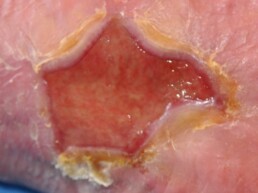
Non-Healing Wounds
Wound clinics and caregivers have the capacity to save limbs and to save lives…..
The Wound Healing Society (WHS) estimates that the global wound-closure products market will exceed $15 billion by 2022. The advanced wound care market targeting surgical wounds and chronic ulcers is expected to exceed $22 billion by 2024, driven by technological advancement, rising incidences of chronic wounds, and a rising geriatric population. Wounds are not just limited to diabetics and the elderly. Surgical wounds and infected wounds are some of the most difficult and expensive to treat. Underlying conditions ranging from malnutrition, to stress and metabolic syndrome, also predispose patients to chronic, nonhealing wounds. Find out more from the WHS regarding the perils and burdens of chronic and acute wounds HERE.
Key Wound Care Statistics:
- Annually, 6.5 million people in the U.S are medically diagnosed as chronic non-healers and the numbers will likely increase, according to the U.S. National Institute of Health.
- 34 million Americans are living with diabetes right now, and another 88 million are at risk for it. American Diabetes Association
- The financial burden imposed by chronic wounds on society is substantial. In the United States, more than $25 billion is spent by the health care system on treating wound related complications per year. U.S. National Institute of Health.
- Based on estimates from independent sources, it is clear that the magnitude of wounds as a health care problem is sharply rising. WHS white paper HERE.
Key Wound Care Statistics:
A good wound clinic should have the technology and equipment medically engineered to evaluate wounds and help them heal better and faster.
Wound Care:Â Â Â Â Â Â Â Â Â Â Â Â Â
- Diabetic Ulcers
- Venous Ulcers
- Burns
- Surgical
- Chronic Wounds
Opthalmic:
- Ulcers
- Surgical
- Patches
- Ocular Injuries
- Chronic Dry Eye
Common Non-healing Wounds Include:
Pressure ulcers:
Pressure ulcers are most commonly found over bony areas exposed to excessive pressure such as coccyx or tailbone, buttock, hip and heel. They occur due to reduced blood supply to the area. Leading to the death of skin cells and formation of an ulcer. Pressure ulcers are more common in non-ambulatory patients.
Diabetic Foot Ulcers:
Diabetes causes nerve damage that can cause complete loss of sensation in the foot due to which minor foot injuries can lead to ulcers and infections and even gangrene. Diabetic foot is a term used for foot problems in patients with diabetes.
Venous Leg Ulcers::
These ulcers are commonly seen above the ankle. They occur due to insufficiency of the valves in the large leg veins which causes damage to the veins, and the blood from the veins oozes out and collects under the skin.